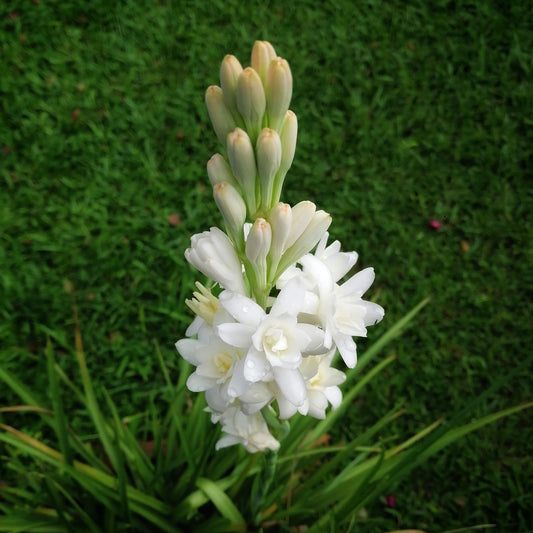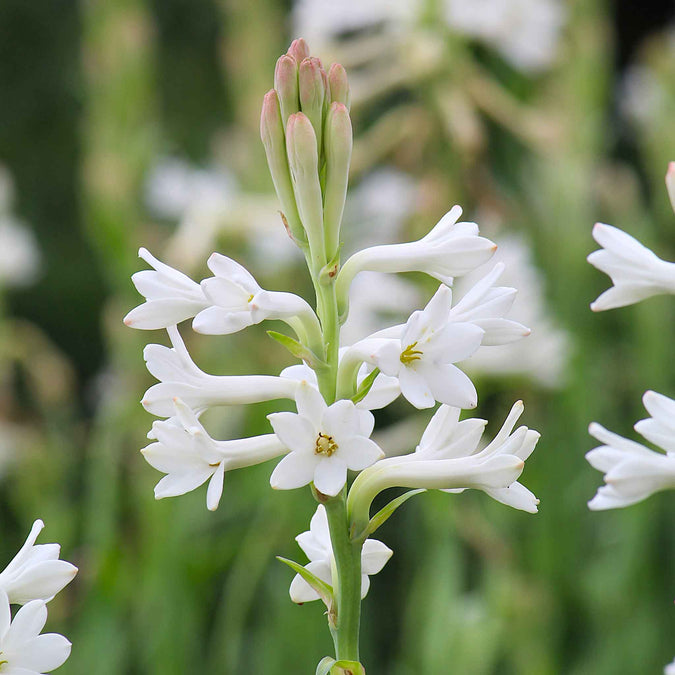
Tuberose, known as Rajnigandha in Hindi, is a fragrant and elegant flower that can transform your garden into a paradise of scent and beauty. This perennial plant, with its nocturnal blooms and intoxicating fragrance, is a favorite among gardeners and florists alike. Whether you're a seasoned gardener or a beginner, this guide will help you cultivate a thriving tuberose garden.
Why Choose Tuberose for Your Garden?
Tuberose is not just a flower; it’s an experience. Here are some reasons why tuberose is an excellent choice for your garden:
- Fragrance: Known for its sweet, spicy scent, tuberose is widely used in perfumes and aromatherapy.
- Aesthetic Appeal: The tall spikes of white or cream-colored flowers add vertical elegance to any garden.
- Easy Maintenance: With proper care, tuberose blooms profusely through the summer months.
- Versatility: It thrives in pots, garden beds, or as cut flowers for indoor decoration.
Step-by-Step Guide to Growing Tuberose
1. Selecting the Right Bulbs
The success of your tuberose garden begins with choosing healthy bulbs. Look for bulbs with a diameter of 15-20 mm as they are more likely to produce robust flower stalks1. Avoid bulbs that appear shriveled or damaged.
2. Preparing the Soil
Tuberose thrives in well-drained, fertile soil. Here’s how to prepare the perfect soil mix:
- Combine one part coco peat, one part sand, and two parts well-decomposed compost to enhance soil quality.
- Maintain a slightly acidic pH (6.0–6.5) for optimal growth.
3. Choosing the Right Location
Tuberose requires ample sunlight—about six to eight hours per day—for healthy flowering. However, in extremely hot climates, provide partial shade during the afternoon to prevent stress on the plants.
4. Planting the Bulbs
Proper spacing and depth are crucial when planting tuberose:
- Plant bulbs 6–8 inches apart and 2–3 inches deep in the soil.
- Ensure that the pointed end of the bulb faces upward.
5. Watering
While tuberose needs consistent moisture during its growing season, overwatering can lead to root rot. Water your plants regularly but ensure good drainage to prevent waterlogging.
6. Fertilizing
Tuberose is a heavy feeder and requires regular fertilization:
- Use a slow-release granular fertilizer rich in phosphorus every four to six weeks during the growing season.
- Avoid overcrowding by dividing clumps every couple of years to maintain healthy flowering.
7. Mulching
Applying mulch around the base of your plants helps retain soil moisture and regulate temperature. Organic materials like straw or wood chips work best.

Caring for Your Tuberose Garden
Pest and Disease Management
Tuberose is generally hardy but can be susceptible to pests like aphids or fungal infections in overly wet conditions. Use organic insecticides or neem oil sprays to keep pests at bay.
Deadheading
Remove spent blooms regularly to encourage new flowers and maintain the plant's appearance.
Winter Care
In colder regions, dig up the bulbs after the growing season and store them in a cool, dry place until spring.

Creative Uses of Tuberose
- Home Decor: Use fresh-cut tuberose flowers in vases for an aromatic indoor atmosphere.
- Weddings and Events: Their elegant appearance makes them popular in floral arrangements.
- Perfume Making: Extract their essential oils for personal use.
Common Mistakes to Avoid
- Overwatering: Excess water can cause root rot.
- Poor Spacing: Crowded bulbs result in fewer flowers.
- Neglecting Sunlight: Insufficient light leads to weak growth and sparse blooms.
With their captivating fragrance and stunning appearance, tuberoses are a must-have for any garden enthusiast.
By following these tips on bulb selection, soil preparation, watering, and care, you can enjoy a flourishing tuberose garden that delights both sight and smell.
Start your gardening journey today, and let your garden bloom with the elegance of tuberoses!


